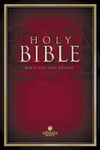Today, in lieu of our regular Throwback Thursday post, we’re pleased to present this guest post by James F. Davis, PhD. Part of the translation and editorial team of the Holman Christian Standard Bible (HCSB), James reflects on how their use of Accordance helped them develop a completely new translation (as opposed to a revision of an earlier translation).
Accordance and the Holman Christian Standard Bible (HCSB)
In their book, HCSB: Navigating the Horizons in Bible Translation, editors E. Ray Clendenen and David K. Stabnow describe the origins, development and philosophy of the HCSB. In the introduction they state, “In all the committees, the Bible study program, Accordance®, took center stage beside the translation itself.” As a part of the original HCSB translation and editorial team in the late 90s and early 2000s, I thought I would flesh out in more detail how the tool of Accordance revolutionized what we did as Bible translators and editors, going way beyond what translations of earlier times had available.
Before I do this, for the record I would just like to mention how the connection of Accordance and the HCSB came to be. The first official General Editor of what we now know as the HCSB was Dr. Arthur Farstad. Dr. Farstad had been a close friend of the originator of Accordance, Dr. Roy Brown, and when the translation was being considered the use of some computer aids was a given. So the team started to purchase Apple Macintosh computers simply because Accordance at that time only ran on the Macintosh platform. Sadly, four months into the project, Dr. Farstad passed away.

Speed: Time is money, especially when you have teams of committees trying to develop a brand new translation. Using Accordance dramatically increased the speed of simple tasks such as looking up a word in a lexicon or finding a particular verse reference. Someone proficient in performing these tasks manually might be able to accomplish them in a minute or so—that is, if he or she is successful on the first try (good luck with that Hebrew root on a manual search!). With Accordance, these tasks take only a few seconds. Words were looked up thousands and tens of thousands of times—almost always in multiple lexicons—so Accordance dramatically increased our speed in making good decisions. The time for other research such as concordance searches on Greek and Hebrews words was so fast that we routinely did them as we went along. Performing such searches manually would have slowed the whole team down waiting for some result.
Accuracy: We always had up to date lexicons in our Accordance arsenal including Louw and Nida’s Greek-English Lexicon of the New Testament based on Semantic Domains (1988) and initially the second edition but then the third edition in 2000 of Danker’s updated A Greek-English Lexicon of the New Testament and Other Early Christian Literature (BDAG). For the Old Testament, we had Koehler and Baumgartner’s The Hebrew and Aramaic Lexicon of the Old Testament, only recently translated into English (2000). All these lexicons were fully searchable for words or verses on any word meaning issue that we were looking at. For more complete word studies lexical information was coupled with concordance search analysis. For comparison purposes we also had access to all the major English translations, new and old (as well as major foreign languages), that could easily be laid out in Accordance in parallel columns next to original language texts. In the Synoptic Gospels we used gospel harmonies in Accordance to help ensure that similar Greek phrases were rendered the same while differences were also noted and treated as such. Bible dictionaries such as the Anchor Bible Dictionary and Hebrew and Greek Grammars were also used as research and evaluative tools.
Unique Analysis: Computer Bible programs in general have been a tremendous asset to all translations done in the past decade or so, but Accordance was used in one more critical way that probably gave us a significant edge in developing a new translation. As the translation was getting underway, Dr. Brown trained me to develop Accordance modules for draft books and editions of the HSCB. Later, I trained another team member to help do this. So as each book of the Bible was sent in or revised I could convert the work into a usable draft edition module of the HCSB that our team could install in its Accordance programs. In this way, we could check and revise our own work for accuracy and consistency in the developmental stage of the translation. This proved to be a very powerful tool in making the HCSB the translation that it is today.
Lastly, I would say that Accordance made the HCSB translation process much more enjoyable than it would have been if we would not have had it. That’s because for Bible scholars and students who like Bible study, Accordance is fast and fun.
Sincerely,
James F. Davis, PhD
Were you aware that Accordance played such a pivotal role in the development of the HCSB translation?

